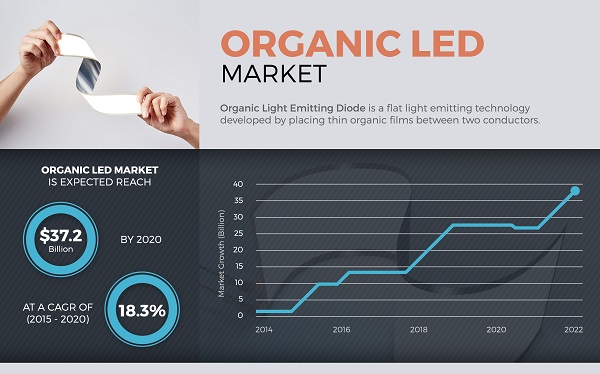The term organic LED, or OLED, has now become synonymous with consumer electronics and automotive market. The latest range of next-generation devices, such as televisions, monitors, smartphones, notebooks & tablets, and automotive screen displays boast of OLED screens, which are the current rage. The organic light emitting diode technology has gained swift approval from all quarters in the electronics industry, and this has led to an emergent market for OLED market.
The global OLED market has gained rapid momentum in the recent years, owing to an upsurge in the demand for cutting-edge electronics and lighting solutions. Organic LED lights have a lucrative industry due to its proven popularity. Its efficiency and low power consumption when used in gadgets has enhanced its demand across various devices. Moreover, the technology, when used in sync with high-definition cameras has ensured a better picture quality. What has pushed the market even further, is its ability to make the device less heavy and more durable, as compared to the traditional LED lights and displays.
According to experts, the entire organic LED market is estimated to earn a whopping $37.2 billion by the year 2020. This would be possible with a projected CAGR of 18.3% during the period 2015–2020. Further, the industry sees major potential for growth with the rise in demand for more eco-friendly lighting solutions.
 |
|
(Photo courtesy of Ketki Vaze) |
Smartphones’ best bet on OLED displays
Read any product specification of a smartphone or a mobile computing device, and you are bound to come across the mention of an OLED monitor or light. The latest range of smartphones doing the rounds in the market have adopted the organic LED technology in the design and creation of displays that are efficient and emit light themselves. The inclusion of this technology in phone displays was first a pioneering move, and this has inspired a slew of other phone companies to catch in on the trend. The use of OLED displays was first encouraged by Samsung, and the trend immediately caught on. To say the least, it turned out to be the best bet for display technologies.
Further, even Apple’s next version of iPhone 8 is also touted to have a curved screen feature. Though the company traditionally used the LCD technology for its phone until now, the curved screen would be feasible only with the help of OLED display technique. This would mean the kickstart of another trend, wherein major phone manufacturers around the world are sure to embrace OLED in their displays, following in Samsung’s and Apple’s footsteps.
While the mass production of this display is not easy, it offers several other benefits. OLED displays possess a higher contrast feature than LCDs. Moreover, glancing at an OLED screen from narrow or diagonal angles does not distort the color or contrast to the human eye. Television screens and smartphone displays are now set to rely on organic LEDs as these benefits are sure to encourage more market participation by electronic manufacturers.
Automotive industry to swear by OLED lighting
After penetrating the smartphone screens and lighting market, organic LEDs have now taken the automotive industry by storm. Automakers have adopted the use of OLED technology in the creation of car display panels, as well as internal and external lighting solutions. Not only is it affordable, but also adds to the safety and style factor. Cars that are equipped with OLED panels are more comfortable, take us lesser trunk space, and are easily visible to other cars and pedestrians. When compared to traditional LCDs and LEDs, they do not require specialized optics, and contribute to overall weight reduction, fuel efficiency, and less power consumption. The ability of OLED displays to achieve high levels of reliability and thermal stability under the typical application conditions has also made them an obvious choice as a display and lighting solution. These added benefits have triggered a faster adoption rate for OLED in the automotive industry.
The latest range of OLEDs have taken over from traditional lighting displays with great fervor. Greatly surpassing the capabilities promised by their LED counterparts, the OLED screens and lighting solutions have raised expectations a notch higher. Which probably means that this technology is here to stay. This is definitely due to the fact that it operates as its own lighting source and color array simultaneously.
With the rapid progress of the industry, the roll-to-roll production capacities of OLED screens is set to become more affordable and lead to a decline in its exorbitant rates. This will ensure that the price of employing organic LED technology is phones, computers, and automotive vehicles is also set to decline.
(Contributed by Mufassira, content writer at Allied Analytics LLP.)












